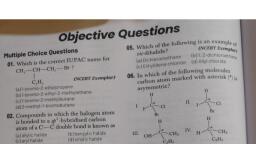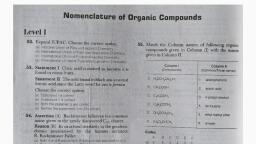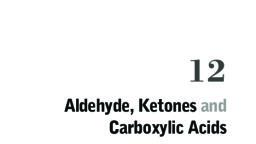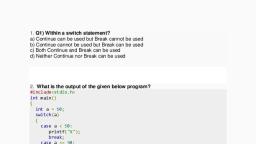Page 1 :
SAMPLE, QUESTION, PAPER, , , , , , , , , , , , , , , , , , , , , , , , BLUE PRIN, Time Allowed : 90 Minutes Maximum Marks : 35, S. No. Chapter Section-A Section-B Section-C Total, 1. The Solid State 5 3 1 9, 2. Solutions 3 5 0 8, 3: The p-Block Elements 5 4 1 10, 4. Haloalkanes and Haloarenes 4 4 1 9, 5. Alcohols, Phenols and Ethers 3 4 3 10, 6. Biomolecules 5 4 0 9, Total MCQs 25(20) 24(20) 6(5) 55(45)*, , , , , , , , , , , , , , , , , , *Each MCQ carries 0.77 marks.
Page 2 :
Subject Code: 043 SQP-5, , CHEMISTRY, , Time allowed : 90 Minutes Maximum marks : 35, , , , , , , , General Instructions :, , The Question Paper contains three sections., , Section A has 25 questions. Attempt any 20 questions., , wn, , Section B has 24 questions. Attempt any 20 questions., Section C has 6 questions. Attempt any 5 questions., All questions carry equal marks., , Awe, , There is no negative marking., , SECTION - A, , This section consists of 25 multiple choice questions with overall choice to attempt any 20 questions. In case, more than desirable number of questions are attempted, ONLY first 20 will be considered for evaluation., , 1. Schottky defect is, (a) vacancy of ions (b) delocalization of ions, (c)_ interstitial vacancy of ions (d) vacancy of only cations., , 2. Match the column I with column II and mark the appropriate choice., , , , , , , , , , , , Column I Column I, (A) | CsH;OH + CH;COClI in presence of pyridine | (i) | Unsymmetrical ether, (B) | C3H,ONa + C,;HsBr (ii) | p-Nitrophenol, A wae, (©) |CH;CH,OH 45> (iii) | Ester, (D) | Intermolecular hydrogen bonding (iv) | Symmetrical ether, , , , , , , , , , , , , , (a) (A) > (i) (B) > Giii), (Q) > (ii), (D) > (iv) (Bb) (A) > (iii), (B) > @, (©) > (iv), (D) > (ii), (c) (A) > (ii), B) > ii), (CE) > (iv), (D) >) (d)._ (A) > Civ), (B) > (i), (C) > Git), (D) > (iti), , 3. Glycosidic linkage is an, , (a) amide linkage (b) ester linkage (c) ether linkage (d) acetyl linkage., , 4. The yellow colour in NaCl crystals is due to, (a) excitation of electrons in F-centres (b) reflection of light from CI ions on the surface, (c)_ refraction of light from Na* ions (d) all of the above., , 5. Arrange the given compounds in decreasing order of boiling points., , ic, CH,CH,CH,CH,Cl CHy—C—Cl_ CH,—CH,~ CH—Cl, I CH, CH,, it mI, (a) I>MI>II (b) I>I> II (c) I>1> 1 (d) IN>I>1, , Chemistry 51
Page 3 :
10., , 11., , 12., , 13., , 52, , Which of the following represents a peptide chain?, , (a) _nu—c—nn—t —NH-—C—NH— (b) —NH—C—CH,— CH,CH,— NH—CH,CH,— C—, fry | \, (c) —NH—CH;=- C—NH—CH,—C—NH-—CH,— (d) —NH—CH,CH,—C— NH— NH— CH;— C— CH;yy J, , Ethers have lower boiling points than their corresponding isomeric alcohols because of, (a) hydrogen bonding in alcohols that is absent in ethers due to low polarity, , (b) hydrogen bonding in ethers due to high polarity, , (c) insolubility of ethers in water due to less polarity, , (d) inertness of ethers as compared to alcohols., , Which of the following fluoride of xenon has zero dipole moment?, (a) XeF (b) XeF3 (c) XeFy (d) XeF,, , Chlorobenzene can be prepared by reacting aniline with, , (a) hydrochloric acid in the presence of nitrous acid, , (b) cuprous chloride in the presence of aluminium chloride, , (c) chlorine in the presence of aluminium chloride, , (d) hydrochloric acid in presence of nitrous acid followed by heating with cuprous chloride., , , , , , , , , , , , Match the compounds given in column I with the hybridisation and shape given in column II and mark the, correct option., Column I Column II, (A) | XeF, (i)__| distorted octahedral, (B) | XeO3 (ii) | square planar, (C) | XeOF, (iii) | pyramidal, (D) | XeFy (iv) | square pyramidal, , , , , , , , , , , , , , A B c D, (a) (iv) (iit) it), (b) Gv) (i) (ii) (iii), () @) (iit) Gv) (it), (d) i) ii) Gav) (ii), ‘A metal has a fcc lattice. The edge length of the unit cell is 404 pm. The density of the metal is 2.72 g cm™., The molar mass of the metal is, (N, Avogadro’s constant = 6.02 x 10° mol!), (a) 27g mol?! (b) 20g mol!, (c) 40g mol?! (d) 30g mol!, , Complete the missing links., ale. KOH CH;ONa, , CH,CHBrCH, C2804 yy SHBY gy SONS 7, eroxide, , x Y Zz, , (a) CH;CH=CH, CH;CH(Br)CH,Br CH;CH(OH)CH;, (b) CH;CH=CH, CH;CH,CH,Br CH,;CH,OCH,CH;, (c) CH;CH=CH, CH;CH(Br)CH; — CH;CH,OCH,CH;, (d) CH;CH=CH, CH;CH,CH,Br CH,CH,CH,OCH;, , How many atoms are there in a pyranose ring?, (a) 3 (b) 5 (c) 6 (d) 7, Class 12
Page 4 :
14., , 15., , 16., , 17., , 18., , 19., , 20., , 21., , 22., , 23., , 24., , Which of the following compounds have square pyramidal geometry?, (a) CIF; (b) IC, (c) IF, (d) CIFs, , H,S is a toxic gas used in qualitative analysis. If solubility of H2S in water at STP is 0.195 m, what is the value, of Ky?, , (a) 0.0263 bar (b) 69.16 bar (c) 192 bar (d) 282 bar, The major product obtained when chlorobenzene is nitrated with HNO, + conc. H,SO, is, (a) 1-chloro-4-nitrobenzene (b) 1-chloro-2-nitrobenzene, , (c) 1-chloro-3-nitrobenzene (d) 1-chloro-1-nitrobenzene., , On heating, chloric acid decomposes to, , (a) HClO, Cl, Oy and H,0 (b) HCIO,, Cl), Oy and H,O, , (c) HClO, Cl, and H,0, (d) HCl, HClO, Cl,0 and H,O, , Most common types of secondary structures of proteins are, , (a) o-helix and B-helix structures (b) o-helix and B-pleated sheet structures, (c)_ right and left hand twisted structures (d) globular and fibrous structures., , A metal crystallises with a face-centred cubic lattice. The edge of the unit cell is 408 pm. The diameter of the, metal atom is, , (a) 288 pm (b) 408 pm (c) 144pm (d) 204 pm, , Whatare the conditions for an ideal solution which obeys Raoult’s law over the entire range of concentration?, (a) AmixH = 0, AmixV = 0 (b) AmixH = +ve, AmixV = 0, , (c) AmixH! = 0, AmixV = +ve (d) Ani! = 0; AmixV = 0, , Keratin, a structural protein is present in, (a) hair (b) wool (c) silk (d) all of these., , Out of benzene and phenol, phenol is more easily nitrated because, , (a) presence of —OH group in phenol increases the electron density at ortho and para-position, (b) presence of —OH group in phenol decreases the electron density at ortho and para-position, (c)_ nitration being electrophilic substitution requires less density at ortho and para-position, , (d) phenol is more reactive than benzene due to —R effect., , Match the column I with column II and mark the appropriate choice., , , , , , , , , , , , , , , , Column I Column IT, 5 Po-Ps_ 2, (A) | Ethyl alcohol + Water | (i) P “+N, (B) Benzene + Toluene (ii) _| Effect of pressure on gas solutions, (C) Henry's law (iii) | Ideal solution, (D) | Raoult’s law (iv) | Azeotropic mixture, , , , , , , , , , , , , , (a) (A) > (i), (B) > (ii), (C) — (iti), (D) > (iv), (b) (A) > @, (B) > (iii), (C) > (ii), (D) > (iv), (c) (A) > (iv), (B) > (iii), (C) > Gi), (D) > @), (d) (A) > iii), (B) > (ii), (C) > (i), (D) > (iv), , Which one of the following is most electronegative element configuration?, (a) 1s’, 23? 2°, 33? 3° (b) 1s’, 23? 2p%, 3s! (c) 1s’, 2s? 2p°, 3s? (d) 1s?, 2s” 2p°, , Chemistry Bo)
Page 5 :
25. Total no. of voids in 0.5 mole of a compound forming hexagonal closed packed structure are, (a) 6.022 x 107 (b) 3.011 x 10% (c) 9.033 x 107 (d) 4.516 x 107, , SECTION - B, , This section consists of 24 multiple choice questions with overall choice to attempt any 20 questions. In case, more than desirable number of questions are attempted, ONLY first 20 will be considered for evaluation., , 26. Which of the following species can act as the strongest base?, , (a) “OH (b) “OR (c) “OCH; (a) oy, ‘NO., , 27. What will be the mole fraction of water in a sample of spirit containing 85% ethanol by mass?, , 2, , (a) 0.69 (b) 0.31 (c) 0.42 (d) 0.60, 28. A crystalline solid XY; has ccp arrangement for its element Y. X occupies, , (a) 66% of tetrahedral voids (b) 33% of tetrahedral voids, , (c) 66% of octahedral voids (d) 33% of octahedral voids., 29. Alkyl halides undergoing substitution nucleophilic bimolecular reaction involves, , (a) formation of carbocation (b) racemic mixture, , (c) inversion of configuration (d) retention of configuration., , 30. A unit in nucleic acid which contains ‘base-sugar phosphate’ unit is called, (a) nucleotide (b) nucleoside (c) phosphotide (d) polypeptide., CH; CHy, , 31. TUPAC name of cutter, is, , bu, cl, (a) 3-chloro-2, 2, 3-trimethylbutane, (b) 2-tert-butyl-2-chloropropane, (c)_ 1-chloro-1, 1-dimethyl-2,2-dimethylpropane, (d) 2-chloro-2, 3, 3-trimethylbutane., , 32. The property which is not true about fluorine is, (a) most of its reactions are exothermic (b) it forms only one oxo acid, (c)_ highest electronegativity (d) high F—F bond dissociation enthalpy., , 33. 250 mL of sodium carbonate solution contains 2.65 g of Na,CO3. If 10 mL of this solution is diluted to, 500 mL, the concentration of the diluted acid will be, , (a) 0.01M (b) 0.001 M (c) 0.05M (d) 0.002M, 34, Nucleic acids are, (a) small molecules (b) dipeptides, (c) long chain polymers of nucleotides (d) polypeptides., CH,Cl cl, , “O on, (i) (ii) (iii), Correct order of Sy1 reaction is, (a) ifi>i>ii (b) ifi>ii>i (0c) i>iii>ii (d) i>ii> iii,, , 54 Class 12










































